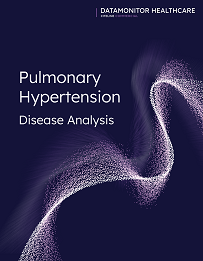Report Library
All Reports
Datamonitor Healthcare CV&Met Disease Analysis: Pulmonary Hypertension
October 03, 2025
Most treatments are solely symptomatic and function by targeting three pathways controlling vasodilation, namely the endothelin, nitric oxide and prostacyclin pathways. For WHO functional class (FC) II and III treatment-naïve patients, dual combination therapy with endothelin receptor agonists (ERAs) and phosphodiesterase 5 inhibitors (PDE5is) is the first-line treatment strategy, while monotherapy with a prostacyclin is a first-line therapy for WHO FC IV patients, with ERAs and PDE5is positioned as add-ons. The TRITON study, which investigated the use of a triple combination of Johnson & Johnson’s Opsumit (macitentan), an ERA, United Therapeutics’ Adcirca (tadalafil), a PDE5i, and Johnson & Johnson’s Uptravi (selexipag), a prostacyclin, in WHO FC II and III patients failed to achieve the primary endpoint of an improvement in pulmonary vascular resistance. Notably, there was a numerical improvement of 41% in hospitalization and all-cause death; however, this was not statistically significant. In support of this positive trend, a post-hoc pooled analysis of patients from the GRIPHON and TRITON trials reached statistical significance, with the rate of disease progression being reduced by 52%. If additional larger trials reveal a significant clinical benefit in disease progression, this will allow prostacyclins to build upon the prevailing trend towards early implementation of polytherapy, which was first established through the AMBITION trial with the dual combination of an ERA and a PDE5i. Additionally, this could markedly expand use of the prostacyclin class by encouraging first-line uptake alongside Opsumit, which is a market leader.
Recently approved therapies and pipeline candidates will diversify the PH market and meet an important unmet need to treat the underlying pathophysiology of the disease rather than just disease symptoms. Of the next-generation candidates, Winrevair, an activin signaling inhibitor that targets the transforming growth factor beta pathway to correct the underlying cause of PH, is the most promising and has been heralded as a game-changer.
| Indications Covered: | Pulmonary Arterial Hypertension (PAH) and Pulmonary Hypertension (PH) |
